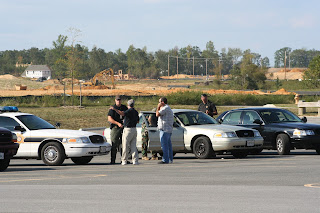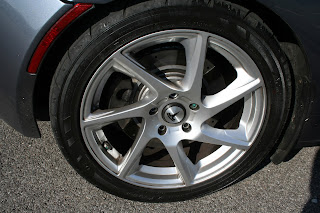 |
| Ripping the Tesla Roadster around our own Top Gear test track. |
The Electric Cool-Car Acid Test
A reprint from the November 2010 online edition of Straightpipe Magazine
 |
| Tesla Roadster was built off the Lotus Elise platform which means it is not very comfortable for tall people. |
I didn’t know that much about it other than it looked like an Elise and was all electric. (It is in fact based on the Elise chassis – manufactured in England then sent to the U.S. for final assembly.)
I love the concept of electric vehicles but until they are cheaper and battery life is longer, I haven’t gone gung-ho into oogling over every electric vehicle concept out there.
Anyway, we readied for the test and set up a skid pad and short slalom at the lot at Blue Crab Stadium, where Autocrossers, Inc., holds events throughout the year. With permission of stadium officials, of course.
Before that, Eric and I went to his house to get his Solstice GXP, the car we autocrossed together this year in B Stock. We thought it would be a good comparison – and possibly use on future comparisons if given the opportunity for FREE ADVERTISING on other cars.
We kept the OEM tires on and didn’t switch to R-compounds to give it a better real-world comparison.
 |
| Seems like a cool concept. I wonder if anything will become of electric cars in the future. |
Shaun Phillips, who was bringing the Tesla down and has been helping to setup the company’s Washington, D.C., dealership, had to make a detour because one of his bosses told him a high-profile government agency was interested in a demonstration. I figured he was trailering it down because of the car’s range, but Shaun showed up just driving the car and said it had plenty of juice for our testing. And to get him home. Tesla Motors' Shaun Phillips explains how the Roadster gets its juice.
The car is pretty quiet with the only hum coming from the accessories. If I actually owned one, I’d have to get a CD with Formula 1 or Top Fuel dragster noises to make my brain comprehend the car was actually doing something.
The car does have a key, but you had to press the “D” button to get it to move then the “P” button when you wanted to park it. The interior is kind of tight for someone taller like me (6′2″), but it’s one of those things I could live with by mashing the gas pedal. Often. Shaun said he has a customer who bought a Roadster who is 6′7″! As a comparison, I’m more comfortable in the Roadster than Eric’s Solstice.
Acceleration from a dead stop was on par with an AWD car — it just went. No power lag or anything. All 240 HP and 240 ft-lbs of torque were *right there* as soon as you stomped on the gas. And like the Elise, the Roadster’s powerplant is over the rear drive wheels, which helps for acceleration as well as handling balance.
Also of note, we were driving an older Roadster — Tesla has a new version which makes 288 HP and 295 ft-lbs of torque. Handling was pretty good but it also had Yokohama Advan Neuva tires. It felt better in the skidpad and through the slalom than the Solstice, but I suspect the OEM Goodyears on the GXP had a hand in that.
The steering on the Tesla felt really good on initial turn in but kind of vague or sloppy the more you turned the wheel. I assume that feeling is because it doesn’t have the tension of a drive belt on a power steering pump. It has a smallish steering wheel, which lends to the whole racecar vibe of the car.
 |
| Nothing to see here officers. Do you hear anybody revving engines and doing crazy things? |
The car definitely attracted attention as many members of the stadium staff, who were preparing for a baseball game that night, came out to take a look at the electric kool car. But this isn’t supposed to be a racecar, really. At this point, especially with it’s $100,000+ pricetag, it’s out of reach for most people, but more affordable electric cars are in the company’s future plans.
Wired magazine had a good article in its October issue profiling Tesla CEO Elon Musk. Basically, the Roadster is just the first step in building the company through electric cars. The second step – a four-door sedan – is getting ready to hit the streets in 2012 inthe form of the Model S. With a battery pack replacing the engine for power, space will be saved, and the car will have more room for passengers and cargo. The claim is that five passengers and two children can fit in the car comfortably.
The third step in Musk’s plan is to offer low-cost electric vehicles. The price on the Roadster is over $100,000 while the Tesla web site lists the base price on the Model S as $49,000, so a more affordable car is definitely a step in the right direction.
The maximum range on the Roadster with a full charge is about 250 miles. Shaun said with more aggressive driving, it’s in the 180-mile range. In comparison, the numbers released on the Model S have it slower 0-60 than the Roadster, however, tripping the clock at a claimed 5.6 seconds is certainly nothing to discount if you happen to line up against one as you’re staring at the “This lane ends in 300 feet” sign while at a stoplight.
The Model S will also have a 300-mile range, upping the Roadster by 50 miles. Being a gearhead, I wonder if the Roadster could be driven to a track day, flogged for the weekend, and still have enough juice to make it back home?
 |
| What is louder? The Tesla "engine" or brake pads clamping on rotors? |
While the Roadster’s pricing is way out of my range, I like the concept. Where have a lot of great automotive ideas come from? The likes of Formula 1 and high-end production cars as concepts trickle down and become more common and cheaper to produce.
Shaun mentioned that the next-generation — the Roadster S — has even more advancements like batteries that are easier to remove and an improved “black box.” The Wired article detailed how Musk recently purchased a production plant in Fremont, Calif., from Toyota for less than $50 million with an eye on Model S production. Along with that and electric cars from Nissan and General Motors (albeit the Chevy Volt is gas assist), it appears that the electric car is in the early stages of entrenching roots in the market.
With the limited range of the electric vehicles on the market now, how can an electric vehicle be used for anything other than local commutes? Enter Coulomb Technologies’ ChargePoint America program, which is made possible by the American Recovery and Reinvestment Act through the Transportation Electrification Initiative administered by the Department of Energy. On Nov. 16, the first curbside public charging station in Washington, D.C., pumps (I can’t help but call them that) offer 220 to 240 volts of charging which is estimated to fully charge electric vehicles within four to six hours.
Also, in the greater metropolitan D.C. area, the program is offering hundreds of free EV charging stations for public and home charging to individuals and businesses, as has been done in other parts of the country.
Is it possible to make a cross-country trip only on electricity alone? I guess it’s possible but at 200 or so miles per tank of electricty with several hours of charge time, it would still be quite the undertaking. But no doubt bolstering ranges of cars while shrinking price tags, coupled with the availability of charging stations (think less of “gas stations” and more of stations available at hotels), it’s hard to imagine that this is going to be a flash in the pan.
https://web.archive.org/web/20110119111907/http://straightpipemagazine.com:80/archives/563
Comments
Post a Comment